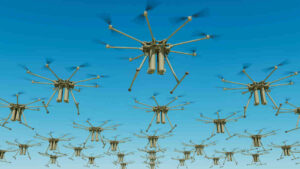BlackRock calls defence tech the next theme to watch as NATO shifts into rearm mode

BlackRock calls defence tech the next big market driver. Pic: Getty Images
- NATO lifts defence spend to 5% after fiery Hague summit
- BlackRock says defence tech is the new theme to watch
- DroneShield’s $61m Euro deal ignites ASX defence run
A few summers ago it would have sounded bonkers, but here we are: NATO leaders have just agreed to jack up their collective defence spending target to 5% of GDP (from a previous target of 2%).
Inked during a white-knuckle summit in The Hague on Wednesday, the pledge is an all-out gear shift, a sign the West is rearming for a world that feels like it’s cracking at the edges.
There was no shortage of drama. Trump arrived at the meeting floating his usual lines about freeloading Europeans and asking what America’s getting in return.
But by the end, after closed-door huddles and some diplomacy, he changed tune: “It’s not a rip-off. We’re here to help them protect their countries.”
And while Trump’s claiming victory, it’s also a win for Europe and especially for NATO’s new secretary general Mark Rutte, who had apparently spent months quietly stitching this together.
The NATO alliance, once rattled and rusty, is now bracing for a far more contested world than the one it thought it was defending a decade ago.
The Russia-Ukraine war has basically rewired its mindset.
Germany, once shy about spending on tanks and missiles, now wants to build Europe’s most powerful military. Sure, not everyone’s on board. Spain and Slovakia are already whining about affordability.
BlackRock all-in on defence
No surprise then that BlackRock, the world’s biggest asset manager, is getting more bullish about the defence sector.
In its latest market outlook, the BlackRock Investment Institute called defence one of the defining themes to watch reshaping global markets right now.
Not just because of war, but because of how war is evolving: AI, drones, and cyber strikes. It’s not the same old battlefield anymore.
BlackRock has recently been rolling out Europe-focused defence ETFs, following surging interest in names like Lockheed Martin, RTX, Northrop Grumman, as well as smaller drone-tech firms.
According to BlackRock, its defence ETFs have already attracted over US$7.5 billion in global inflows this year, a notable shift for a sector once considered too controversial for many investors to stomach.
Aussie defence stocks step up
That shift is already rippling through the ASX, where several homegrown players are starting to look like serious contenders.
Take DroneShield (ASX:DRO).
This week it landed a monster $61.6 million contract from a European military customer, more than its total revenue last year.
It will be shipping handheld counter-drone kits across Q3, and according to CEO Oleg Vornik, this is just the beginning.
“The scale and frequency of orders has been increasing as leading military customers are moving from testing hardware to broader rollouts,” Vornik said.
“DroneShield is well placed to meet the increasing demand.”
Then there’s Elsight (ASX:ELS), which makes battlefield-grade connectivity systems.
Its Halo unit, a plug-and-play data pipe that stitches together mobile, satellite and RF links, has become the backbone for unmanned military vehicles.
So far this year, the company has clinched over US$14.7 million in contracts from a single European OEM. That’s a 600% revenue surge.
And if the fight is moving into the digital realm, Vection Technologies (ASX:VR1) is there too.
The company’s virtual reality training tech is now being used by defence clients to simulate missions, map out battlefields, and rehearse critical ops.
Meanwhile, Harvest Technology Group (ASX:HTG) is also filling another critical gap – real-time, secure comms in low-bandwidth or remote environments.
Its Nodestream platform lets remote patrols, ships or field drones stream encrypted video and data back to HQ, even with minimal connectivity.
What next?
If NATO’s 5% goal holds, experts say we’re staring down trillions in new defence spending through to 2035.
And while much of that will go to the usual suspects – Lockheed, Raytheon, Thales – there’s real space for niche, high-tech players that solve modern military problems.
That’s where Australian firms are starting to shine, building the networks, training tools and autonomous brains that will run the battles of the future.
But this isn’t easy money.
Defence contracts are slow, complex and political. You need trust and staying power.
Which means the Aussie firms that win are likely the ones who have already laid the groundwork.
ASX DEFENCE-RELATED STOCKS
| Security | Description | Last | Month % | 6-month % | 12-month % | Market Cap |
|---|---|---|---|---|---|---|
| TTT | Titomic Limited | 0.270 | -7% | 59% | 275% | $357,954,767 |
| ELS | Elsight Ltd | 1.500 | 148% | 290% | 219% | $273,520,523 |
| ASB | Austal Limited | 6.075 | 19% | 97% | 149% | $2,472,326,858 |
| HCL | Highcom Ltd | 0.300 | 67% | 88% | 131% | $30,804,802 |
| AL3 | Aml3D | 0.160 | 3% | -9% | 129% | $86,038,495 |
| EOS | Electro Optic Sys. | 2.600 | 61% | 118% | 74% | $503,604,978 |
| CDA | Codan Limited | 19.670 | 12% | 21% | 69% | $3,605,996,922 |
| DRO | Droneshield Limited | 2.235 | 85% | 249% | 51% | $1,871,513,148 |
| OEC | Orbital Corp Limited | 0.115 | 22% | 15% | 43% | $18,125,769 |
| BRN | Brainchip Ltd | 0.195 | -9% | -38% | -3% | $384,890,930 |
| 1CG | One Click Group Ltd | 0.008 | 14% | -20% | -11% | $9,458,289 |
| 3DA | Amaero Ltd | 0.330 | 20% | 29% | -14% | $238,274,469 |
| BIS | Bisalloy Steel | 3.300 | -9% | -26% | -15% | $157,123,811 |
| AJX | Alexium Int Group | 0.007 | -13% | -42% | -36% | $11,105,001 |
| BCT | Bluechiip Limited | 0.003 | 0% | 0% | -40% | $3,616,878 |
At Stockhead we tell it like it is. While Harvest Technology is a Stockhead advertiser, it did not sponsor this article.
This story does not constitute financial product advice. You should consider obtaining independent advice before making any financial decision.
Related Topics
UNLOCK INSIGHTS
Discover the untold stories of emerging ASX stocks.
Daily news and expert analysis, it's free to subscribe.
By proceeding, you confirm you understand that we handle personal information in accordance with our Privacy Policy.








